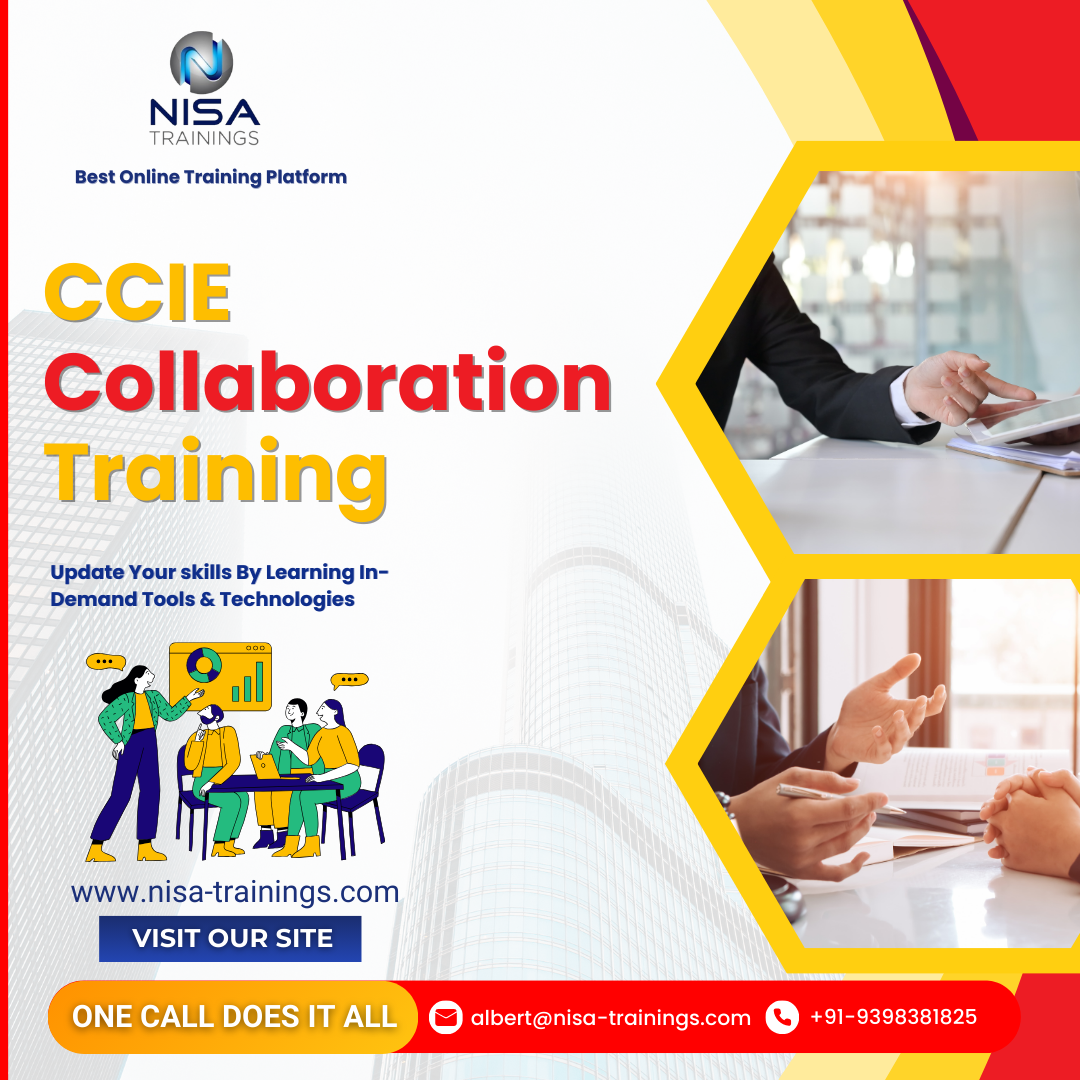CCIE Collaboration Training
CCIE Collaboration training is an advanced program designed for professionals who are aiming to achieve Cisco’s Certified Internetwork Expert (CCIE) certification in the collaboration domain. This program provides a deep dive into the deployment, configuration, management, and troubleshooting of Cisco collaboration technologies, which are essential in modern enterprise communications systems, including voice, video, and data.

Why should you choose Nisa For CCIE Collaboration Training?
Nisa Trainings is the best online training platform for conducting one-on-one interactive live sessions with a 1:1 student-teacher ratio. You can gain hands-on experience by working on near-real-time projects under the guidance of our experienced faculty. We support you even after the completion of the course and happy to clarify your doubts anytime. Our teaching style at Nisa Trainings is entirely hands-on. You’ll have access to our desktop screen and will be actively conducting hands-on labs on your desktop.
Job Assistance
If you face any problem while working on CCIE Collaboration Course, then Nisa Trainings is simply a Call/Text/Email away to assist you. We offer Online Job Support for professionals to assist them and to solve their problems in real-time.
The Process we follow for our Online Job Support Service:
- We receive your inquiry for Online Job
- We will arrange a telephone call with our consultant to grasp your complete requirement and the tools you’re
- If our consultant is 100% confident in taking up your requirement and when you are also comfortable with our consultant, we will only agree to provide service. And then you have to make the payment to get the service from
- We will fix the timing for Online Job Support as mutually agreed by you and our consultant.
Course Information
CCIE Collaboration Training
Duration: 25 Hours
Timings: Weekdays (1-2 Hours per day) [OR] Weekends (2-3 Hours per day)
Training Method: Instructor Led Online One-on-One Live Interactive
Sessions.
COURSE CONTENT :
1. Core Collaboration Concepts
- Overview of Collaboration Solutions: Understanding Cisco’s unified communication and collaboration systems.
- Network Infrastructure: An introduction to collaboration network design, topology, and key Cisco collaboration products.
- Collaboration Applications: Introduction to Cisco collaboration applications like Cisco Jabber, WebEx, and Cisco TelePresence.
2. Unified Communications (UC) Infrastructure
- Cisco Unified Communications Manager (CUCM):
- CUCM installation, configuration, and maintenance.
- Call routing, dial plans, and call control mechanisms.
- CUCM clustering and redundancy configurations.
- Cisco Unified Communications Manager Express (CME):
- CME setup and integration with CUCM.
- Configuration of CME for small office solutions.
- Cisco Unified Border Element (CUBE):
- Role of CUBE in VoIP communications.
- Configuration and troubleshooting of SIP trunking with CUBE.
3. Voice and Video Protocols
- Session Initiation Protocol (SIP):
- Configuration of SIP trunking, SIP endpoints, and SIP gateways.
- Understanding SIP signaling, SIP messages, and troubleshooting techniques.
- H.323 and MGCP:
- Configuring H.323 gatekeepers, endpoints, and MGCP gateways.
- Dial-peer configuration and troubleshooting.
- Voice and Video Codecs:
- Understanding codec types, voice/video quality, and bandwidth management.
- Video conferencing protocols and configuration (e.g., H.264, VP8).
- Voice Gateways and Call Control:
- Integrating Cisco ISR routers as voice gateways.
- Voice gateway troubleshooting for call drops, audio issues, etc.
4. Collaboration Security
- Encryption and Security Protocols:
- Securing SIP signaling, media encryption, and securing endpoints.
- Configuring Cisco Unified Communications Security (CUSP) and SRTP.
- Firewall and NAT Traversal:
- Understanding firewalls, NAT, and VPNs in collaboration solutions.
- Implementing NAT traversal for SIP communications.
- Endpoint Security:
- Securing IP phones, Cisco Jabber, and collaboration endpoints.
- Configuring Cisco Identity Services Engine (ISE) for authentication and authorization.
5. Quality of Service (QoS)
- QoS Overview:
- Introduction to QoS concepts for voice, video, and real-time collaboration traffic.
- DiffServ model, traffic classification, and marking.
- Traffic Policing and Shaping:
- Configuring traffic policing, shaping, and congestion management for VoIP.
- Congestion Avoidance and Prioritization:
- Configuring congestion avoidance techniques like WRED.
- Implementing traffic prioritization for real-time communication (voice and video).
6. Collaboration Applications and Management
- Cisco Jabber:
- Configuring and troubleshooting Cisco Jabber for presence, instant messaging, voice, and video.
- Integrating Jabber with CUCM, Unity Connection, and WebEx.
- Cisco WebEx and Cloud Collaboration:
- Setting up Cisco WebEx Meetings and Cisco WebEx Teams.
- Managing and troubleshooting cloud-based collaboration solutions.
- Cisco Unity Connection:
- Configuring voicemail, call handlers, and message retrieval.
- Integration with CUCM and voicemail troubleshooting.
- Cisco TelePresence:
- Setup and management of Cisco TelePresence video conferencing systems.
- Troubleshooting video quality and end-to-end collaboration setup.
7. Collaboration Network Design
- Collaboration System Design:
- Best practices for designing scalable collaboration solutions.
- High availability and redundancy design for UC systems.
- Collaboration Network Topology:
- Configuring and managing a multisite collaboration network.
- WAN optimization for voice and video traffic across remote locations.
- High Availability and Fault Tolerance:
- Implementing redundancy for CUCM, gateways, and collaboration applications.
- Designing fault-tolerant systems using Cisco Unified Communications Survivable Remote Site Telephony (SRST).
8. Troubleshooting Collaboration Networks
- Troubleshooting Methodologies:
- Systematic troubleshooting approach using Cisco tools like RTMT, CDR, and debugs.
- Troubleshooting voice and video call failures, registration issues, and media problems.
- Common Collaboration Issues:
- Dial plan issues, call routing problems, and codec mismatches.
- Video call failures, poor quality, and endpoint registration issues.
- Advanced Troubleshooting Scenarios:
- Troubleshooting complex scenarios involving CUCM, CME, CUBE, and collaboration applications.
